![]()
![]()
![]()
Use LEFT and RIGHT arrow keys to navigate between flashcards;
Use UP and DOWN arrow keys to flip the card;
H to show hint;
A reads text to speech;
68 Cards in this Set
- Front
- Back
|
What is generativity? What are phonemes? The first step in children's language learning is what? When does it occur? When do people learn to produce sounds of native language? What are morphemes? |
Using finite set of words in vocabulary to make infinite sentences Basic units of sound in speech Phonological development - mastery of the sound system of their language Birth through adolescence 6 months through adolescence Smallest units of meaning |
|
|
The second component in language learning is what? When does it occur? When does it happen a lot? What is syntax? The third component in language learning is what? |
Semantic development - learning the system for expressing meaning in a language [includes word learning] Birth through lifespan; after 10 months to early school age Rules in a language [aka grammar] Syntactic development - Learning syntax |
|
|
What is the fourth component in language learning?
What is the fifth component in language learning? |
Pragmatic development - learning how language is used [when to say what in social situations/etc.] Metalinguistic knowledge - knowledge about language and its properties |
|
|
Language is primarily represented and controlled by the left or right hemisphere of the brain? Give two reasons why |
Left 1 - Left side is innately predisposed to process language and not other auditory stimuli 2 - Left side because of speech's acoustic properties to detect small differences in timing, whereas right side detects differences in pitch |
|
|
When does the critical period for language development end? |
Sometime between 5 y.o. and puberty. |
|
|
What two results strongly suggest that the neural circuitry supporting language learning operates differently (and better) during the early years? |
Adults beyond the critical period suffer permanent language impairment from brain damage compared to children, whose other areas of the young brain can take over Adults who learn language after the critical period use different neural mechanisms to process the language compared to adults who learned their second language in infancy |
|
|
What does the less-is-more hypothesis say? |
Perceptual and memory limitations make kids extract and store smaller chunks of language than adults. Because the crucial building blocks of language (the meaning carrying morphemes) tend to be quite small, young learners’ limited cognitive abilities may actually facilitate the task of analyzing and learning language. |
|
|
What is infant-directed speech? What are the two components to IDS? How does IDS aid infants' language development? |
Type of speech that males/females/parents/non-parents/adults/young children use when talking to babies Emotional tone [affection] Exaggeration [slow speech, variable pitch, clear vowels, facial expressions] Draws infant's attention to the speech itself [infants prefer IDS to adult directed speech, even when not in their native language] |
|
|
The first step in language learning, figuring out the sounds of one's native language, occurs in the womb where fetuses develop a preference for their mother's voice and language. The basis for this very early learning is ________ |
Prosody - The characteristic rhythm, tempo, cadence, melody, intonational patterns, etc. which a language is spoken |
|
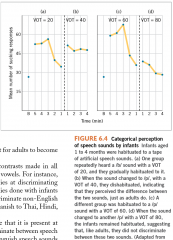
What is categorical perception? These are produced in the exact same way, except for what crucial difference? |
![Perception of speech sounds as belonging to discrete categories [b sounds like b, p sounds like p and are on a continuum]
Voice onset time [VOT] - length of time between when the air passes through the lips and when the vocal chords start vibrating](https://images.cram.com/images/upload-flashcards/37/35/00/24373500_m.png)
Perception of speech sounds as belonging to discrete categories [b sounds like b, p sounds like p and are on a continuum] Voice onset time [VOT] - length of time between when the air passes through the lips and when the vocal chords start vibrating |
|
|
What happens to speech perception by 12 months old? Is this just limited to speech? |
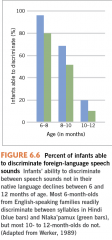
Infants lose the ability to perceive speech sounds that are not part of their native language No, occurs in ASL too |
|
|
What is word segmentation? When does it occur? How do infants find words in pause-free speech? What are distributional properties? |
Figuring out when one word ends and another begins [statistical learning] Second half of first year Pick up regularities in their native language [ex. English stresses second syllable, French stresses end of phrase] Certain sounds are more likely to appear together than others |
|
|
What three things happen around 6-8 weeks in regards to preparation for talking? |
Cooing - oooooh/aaah and other noises to gain motor control over vocalization Infants become aware their vocalizations get responses from others and make more noises w/parents Start imitating sounds of their conversational partners |
|
|
When does babbling occur? What is a key component to babbling occurring? Do ASL kids babble? |
~6-10 months Native language exposure Yes w/there hands |
|
|
Even before infants start speaking, they display the beginnings of communicative competence: the ability to communicate intentionally with another person What is the first indication of communicative competence? |
Turn-taking [ex. games where the infant has the opportunity to alternate between an active and passive role to learn how to use language to converse with others] |
|
|
The first step for infants to acquire meanings of words is to address the problem of reference. What does this mean? Infants begin to produce words between ____-____ months, the words a child is able to say are referred to as the child's ____________ ____________ |
To start associating words and meaning 10-15 months; productive vocabulary |
|
|
Infants’ early word productions are limited by their ability to pronounce words clearly enough that an adult can recognize them. How do they solve this? |
Use simplification strategies [leaving out difficult parts of words/reorder parts of words to make the beginning of them easier |
|
|
What types of words do English-speaking infants focus on in the beginning? Why? |
Nouns (as well as words easy to picture) Nouns label entities whereas verbs represent relations among entities & the proportion of nouns in very young children’s vocabularies is related to the proportion of nouns in their mother’s speech to them |
|
|
Initially, infants say the words in their small productive vocabulary only one word at a time. This phase is referred to as the ______________ ________ Why? Children want to talk about soon outstrips the number of words in their vocabularies, so they do what? |
Holophrastic period Because the child typically expresses a “whole phrase”—a whole idea—with a single word Overextension - use a word in a broader context than is appropriate [ex. dog for any four legged animal/daddy for any male] |
|
|
What happens at around 18 months old in relation to language development? What are three ways other than IDS that adults help infants learn words? |
Vocabulary spurt Highlight new words [put them at end of sentence/label objects already in kid's view] Play naming games 'where's your nose' Spatial consistency w/objects being labeled |
|
|
What is fast mapping? Ex.? What is the mutual exclusivity assumption? What is the whole-object assumption? |
Rapidly learning a new word by hearing the contrastive use of a familiar and unfamiliar word Get “the chromium tray, not the red one.” Children expecting something only has one name Children expect a novel word to refer to a whole object rather than to a part, property, action, or other aspect of the object |
|
|
Children also use pragmatic cues [social context for word learning]. Give two examples How do kids use linguistic context to find the meaning of words? |
Adult's focus of attention - kid picks up on the eyegaze of the adult and the label Intentionaltiy - kid picks up on the adult being pleased with their intention 'Sibbing' 'a sib' and 'some sib' indicated whether it is a verb, count noun, or mass noun |
|
|
How do kids use grammatical category to find the meaning of words? What is shape bias? |
Hear how a word is introduced to tell the meaning of it Children extend a novel noun to novel objects of the same shape, even when those objects differ dramatically in size, colour, and textur |
|
|
What is cross-situational word learning? What is syntactic bootstrapping? |
A child might observe that whenever “dax” is said, one of those four objects is always present, and thus that object is probably “the dax.” Using grammatical structure of whole sentences to figure out meaning |
|
|
When do kids start making words into full sentences? What are the first types of sentences? When do children become capable of producing four word sentences & make complex sentences containing more than one clause [“Can I do it when we get home?” “I want this doll because she’s big”] |
~2 years old Telegraphic speech - two-word utterances ~2.5 years old |
|
|
What is overregularization? What are collective monologues? |
Errors where kids treat irregular forms of words as if they were regular [morpheme error] Conversations between kids that involves a series of non sequiturs, the content of each child’s turn having little or nothing to do with what the other child has just said. |
|
|
When do children being producing narratives [descriptions of past events that have the basic structure of a story]? How do parents help? How does this effect children later? Children begin pragmatic development around preschool/kindergarten age, what is key in this? |
~5 years old Scaffolding - kid ends up being better at making narratives on their own a few years later The kid is able to understand beyond the actual meaning of words by taking the perspective of their conversational partner to see irony/sarcasm/hyperbole etc |
|
|
Give an example of children also learning to use information other than words to interpret meaning. What are two ways schoolchildren continue to develop their language? |
4 year olds, not three year olds, can use vocal intonation of an ambiguous statement to figure out a speaker’s intention Interest in multiple meanings of words [riddles/puns/etc] Can understand words simply via definitions |
|
|
How did Chomsky counter Skinners behaviourist approach to language development? What did Chomsky propose instead? |
Chomsky stated we can understand/produce sentences never heard before [generativity]
Universal grammar - hard-wired set of rules that are common to grammar in all languages |
|
|
What are the two components to language theories? |
Nature v nurture Domain-specific [cognitive/neural mechanisms evolve to support language learning] v domain-general [are they used for learning many different things] |
|
|
What is the argument against Chomsky for nurture instead of his nature viewpoint? Explain the nativist view of the modularity hypothesis |
There are universals in kids' environments [parents around the world want to talk about same things and kids want the same things] The idea that the brain has an innate/self-contained language module that is separate from other aspects of cognitive functioning |
|
|
Using a symbol requires dual representation. What is dual representation? When does it occur? |
The idea that a symbolic artifact must be represented mentally in two ways at the same time— both as a real object and as a symbol for something other than itself Between 2.5 to 3 years old |
|
|
When do kids start drawing pictures of things? What affects when this occurs? |
~3-4 years old Exposure to representational symbols |
|
|
Young infants (< 9 months) can discriminate between many of the world's phonemes This ability declines after 9-10months Why is this not negative? |
Allows for specialization in native phonemes and early narrowing leads to better vocabulary a year later |
|
|
Where does the behaviourist account fall on: Nature v nurture Egocentric v sociocentric Homegeneity v heterogeneity Passive v active |
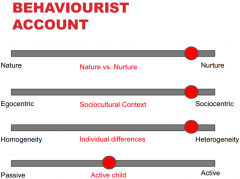
|
|
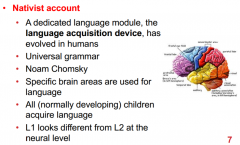
Where does the nativist account fall on: Nature v nurture Egocentric v sociocentric Homegeneity v heterogeneity Passive v active |
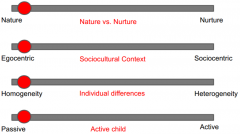
|
|
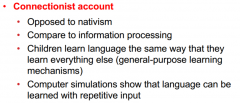
Where does the connectionist account fall on: Nature v nurture Egocentric v sociocentric Homegeneity v heterogeneity Passive v active |
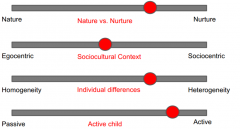
|
|
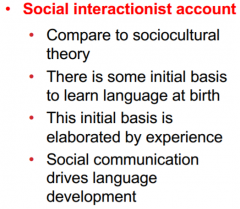
Where does the social interactionist account fall on: Nature v nurture Egocentric v sociocentric Homegeneity v heterogeneity Passive v active |

|
|
|
Concepts are general ideas that organize objects, events, qualities, or relations on the basis of some similarity. Concepts allow us to generalize from previous experience. What are the four themes of conceptual development? |
Nature v nurture - Active child - concepts are a result of active attempts to make sense of the world How change occurs - finding out the processes that form concepts Sociocultural context - concepts created are influenced by the society we live in |
|
|
At ~5 years old, children divide objects they encounter into what three general categories? What's the benefit of dividing objects into these three general categories? |
Inanimate objects People Other animals Different types of concepts apply to different types of objects [ex. saying a platypus is a type of animal lets the child immediately know it can move/eat/reproduce/etc.] |
|
|
The three categories children divide objects into [inanimate objects, people, other animals] can also be interpreted as three informal theories. What are the names of these three informal theories? When do each occur? What does the child understand of each theory at that age? |
Theory of physics [inanimate objects] - beginning of life - occupy space/continuous movement/etc. Theory of psychology [people] - 1.5 years old - Peoples actions reflect their desires Theory of biology [other living things] - 3 years old - Living things vs non living things |
|
|
These informal theories have innate core but also as incorporating learning processes [ex association, observation, and statements of other people] What three characteristics do they share with formal scientific theories? Give examples for each |
1 - They identify fundamental units for dividing all objects and events into a few basic categories Ex. divide all objects into people/animals/plants/nonliving things 2 - They explain many phenomena in terms of a few fundamental principles Ex. understand desire for food & water underlies many behaviours of animals 3 - They explain events in terms of unobservable causes Ex. understand animal's vital activities are caused by sth interal and not external forces that determine the actions of inanimate objects |
|

What does this diagram show? What does this allow for? |
Categorical hierarchies - categories related by set-subset relationships Simplifying the world for kids by letting them draw accurate inferences [knowing a La-Z-Boy = a chair = can use general knowledge of chairs = infer people sit on La-Z-Boys = La-Z-Boys aren't lazy, and are not boys |
|
|
How do we know infants form categories as early as three months old? Infants form these categories via what? What are the two main ways perceptual categorization is done? |
Habituate when looking at different breeds of cats, dishabituate when then shown dogs; 6 month olds do the same between mammals & fish Perceptual categorization - grouping objects based on similar appearance Via specific parts instead of the object as a whole [looking at wheels to categorize automobile] Overall shape |
|
|
When do infants begin perceiving causality between physical events? Children under two years old understand causality in what two ways? |
~6 months old Physical causality causing expectations of inanimate objects [one hits the other, and changes direction] Physical causality gives an ability to remember and imitate sequences of actions [putting rattle in rattler makes it rattle] |
|
|
Give two examples of 24 year olds being superior at causal understanding whereby they can infer the causal impact of one variable based on indirectly relevant information about another |
24 month olds understand the blicket detector needs object B to turn it on as object A isn't doing it, whereas 19 month olds randomly choose object A or B 2 year olds understand the causal impact of the length of a tool & angle of the head in trying to choose a tool to reach an object whereas 1 year olds don't |
|
|
How do preschoolers [age 4] see causal reasoning? How can we observe that at age 5, causal reasoning becomes more advanced? |
Think that if a variable causes an effect, it should do so consistently [don't infer a hidden variable was important] -- if it produces an effect inconsistently, then they think there's another variable at play Kids start liking magic tricks! They can't find an obvious causal mechanism that produced the effect, but understand there is one at play |
|
|
Nativists argue children have an innate module for representing &learning about space and that processes spatial information separately from other types of information Empiricists argue children acquire spatial representations via the same types of learning mechanisms & experiences that produce cognitive growth in general, that children adaptively combine spatial and non-spatial information to reach their goals, and that language and other cultural tools, such as puzzles, shape spatial development What are the four beliefs they both agree on? |
From early-on, infants understand basic spacial concepts [above/below/left-of/right-of] Self-produced movement around the environment stimulates processing of spatial info Certain parts of the brain are specialized for coding certain spacial info Geometric info is very important for spatial processing |
|
|
According to Piaget, infants can only form what type of spacial representations during the sensorimotor period?
What was used as evidence for this? |
Egocentric spacial representations - coding spatial locations relative to one's body, without regards to surroundings Kid keeps turning to their left to find the object even if they're turned around |
|
|
How does self-locomotion help infants acquire a sense of space independent of their own location? What else enhances spacial development beyond infancy? Children who did this between ages __ and __ were better at spacial-transformation tasks at age 4.5 year old |
Better depth and drop-offs due to continuous updating of info of surroundings -- this self-locomotion enhances spatial coding Assembling puzzles 1-4 years old |
|
|
Which sense do those who are blind/partially blind use to develop spatial concepts?
Is their spatial sense worse, as good as, or better than regular people? |
Auditory/sense of sound Do as well as blindfolded participants on tasks like being guided in drawing two sides of a triangle on a piece of paper and then being asked to complete the triangle by drawing the third side themselves, or on tasks of exploring unfamiliar rooms |
|
|
Children can use the external environment [landmarks] to find objects that are hidden, only if what two requirements are met? What improves as the infant gets older? When do children have more of an issue making a spatial representation? |
It must be the only landmark in the environment Landmark must be beside the hidden object Can choose among more and more alternative potential landmarks When moving around/landmarks are far from target location |
|
|
When do infants show knowledge of temporal order? Ex.? When do infants show knowledge of duration of events? Ex.? |
~3 months old Presented with photos on left, then right, then repeated etc. Infant starts to know where the photo will be before it comes up ~5 months old Alternate light/dark every 5 seconds for eight rounds, then break the cycle, kid's HR goes down indicating surprise |
|
|
At what age can infants discriminate between longer and shorter durations? How much? How much can they not at this age When can children start understanding time periods on a week/month/years scale? What are two reasons as to why do kids get a better sense of time at 5-6 years old? |
6 months 2:1; 1.5:1 4-7 years old Kindergarten emphasizing cycles/seasons/holidays/daily routines etc. Able to reason if two events started at the same time, but one event ended later than the other, then the event that ended later must have lasted for a longer time. |
|
|
What is the most basic component of numerical understanding? At what age has this been proven to occur? What ratio can infants numerically discriminate at six months old? 9 months? |
Numerical equality - realizing that all sets of n objects have something in common [2 dogs, 2 cats, 2 cups, 2 balls all have 2 of them] ~5 months old with number three and less 2:1 [not 1.5:1] Can do 1.5:1 |
|
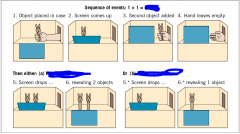
Explain what this experiment tells us about infant arithmetic What are two critiques of this experiment proving infant arithmetic? |
![Infants 6 months old were surprised in the impossible outcome, proving infant arithmetic
Replicability is iffy
Only works when total objects is 3 or less [more objects aren't doable till 3-5 years old]](https://images.cram.com/images/upload-flashcards/43/32/93/24433293_m.png)
Infants 6 months old were surprised in the impossible outcome, proving infant arithmetic Replicability is iffy Only works when total objects is 3 or less [more objects aren't doable till 3-5 years old] |
|
|
The fact infant numerical competence is limited to sets of 3 and less, leads experts to believe these tests aren't based on arithmetic, but instead on perception [mental images].
What is one type of this perception? |
Subitizing - adults/kids quickly looking at a few objects and knowing how many are there |
|
|
Most three year olds can count up to 10. They also follow what five counting principles? |
1 - One–one correspondence: Each object must be labelled by a single number word 2) Stable order:#s always recited in same order 3 - Cardinality: Number of objects in the set corresponds to the last number stated 4 - Order irrelevance: Objects can be counted left to right, right to left, or in any other order 5 - Abstraction: Any set of discrete objects or events can be counted. |
|
|
Give two reasons why Chinese kids are better than US kids at math/counting |
Difference in language [English teens have to be learned separately whereas Chinese rules stay constant] More emphasis on mathematics |
|
|
Give four myths of bilingual learners
|
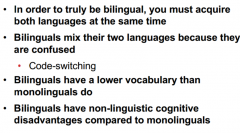
|
|
|
What are the two types of bilingualism? Are both successful? Address the myth that bilinguals have lower vocabulary than monolinguals |
Simultaneous bilingualism - learn both at same time Sequential bilingualism - learn one then other Yes They may have lower vocabulary in one language compared to monolingual peers [especially for 'home' words if English not spoken at home] But their total vocabulary is usually bigger |
|
|
What is code switching in bilingualism? What are two advantages bilinguals have over monolinguals outside of actually knowing the language? |
Switching languages within or between sentences Better at rule-switching and working memory |
|
|
Bilinguals succeed on tasks testing visual discrimination of languages that aren't even theirs. What does this suggest? |
Bilinguals have generalized [not-language specific] advantages over monolinguals |
|
|
Empiricists break down conceptual knowledge into what two parts? Nativists break down conceptual knowledge into what three parts? |
Infants are born with general-purpose, evolutionarilyadaptive learning mechanisms Use these mechanisms to very quicklydiscover properties of the physical world Infants know lots about the physical worldfrom birth This knowledge is specialized into specific modules(core knowledge) Experience elaborates upon this knowledge |
|
|
Core knowledge is broken down into what 4-6 domains of knowledge? |
Objects
Geometry Number Agents [Social groups] [Morality] |
|
|
In objects [cognition], in addition to tracking those objects, infants as young as three months old recognize what three things? What are the two ways infants use geometry? |
Cohesive - objects move as connected/bounded wholes
Continuous - objects move along connected/unobstructed paths Contacts - objects require contact to change each other's motion Very salient landmarks & room's geometry |
|
|
Infant number systems are composed of what two parts?
The discrete/small number system is fast and precise. What evidence is there for the small number system? The approximate/large number system functions according to what? |
Discrete [small] number system - three or less
Approximate [large] number system - >3 Infants' ability to track objects [exhibit surprise during violation-of-expectation effect] Weber's law - the approximate/large system runs in terms of ratio and not absolute # [adults 7:8, infants 2:3] |
|
|
Infants, and adults, understand what four things about agents? |
Goal-directed - ''I'm going to go do x'' = surprise when don't do that Efficient - Move to coffee cup as efficiently as possible Reciprocal - Agentive actions are reciprocal Gaze-directed - Infant knows the person they're watching should be looking at their goal |

